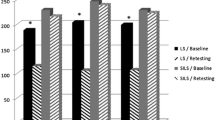Abstract
Purpose
Single-incision laparoscopy (SIL) is potentially less invasive compared with standard laparoscopic surgery (LAP); however, it may be more technically challenging and have a longer learning curve. A two-phase study was conducted to examine the performance of standardized tasks on a surgical simulator by novices during a distributed training period. Phase 1 examined the effect of LAP-specific or SIL-specific training on skill acquisition for both techniques. Phase 2 compared the effectiveness and learning curves of additional instrument types for SIL (straight [STR] vs. dynamic articulating [D-ART]).
Methods
Medical students without previous surgical experience were randomized to LAP-specific training or SIL-specific training, using static articulating instruments [S-ART] for SIL. LAP and SIL scores on the peg transfer (PEG) and pattern cutting (CIRCLE) tasks from the Fundamentals of Laparoscopic Surgery (FLS) were measured at baseline and after four training sessions. In phase 2, a new group of subjects were randomized to SIL training using STR or D-ART instruments, with similar baseline and post-training testing. FLS task scores were calculated and compared according to training regimen and instrument type.
Results
Forty-five subjects completed the study. All scores improved significantly during the training period. Improvement in LAP score was similar between LAP-trained and SIL-trained groups. Improvement of SIL score was better for the SIL-trained group. Final scores were better and the learning curve was shorter for LAP versus SIL technique, with no differences in SIL scores according to instrument type.
Conclusions
LAP technique results in superior task performance with a shorter learning curve compared with SIL technique during a standardized training period. SIL-specific simulator training is better than LAP training alone to improve SIL performance. Neither S-ART nor D-ART instruments for SIL are associated with improved performance or shorter learning curve compared with STR instruments.





Similar content being viewed by others
References
Marks J, Tacchino R, Roberts K, Onders R, Denoto G, Paraskeva P, Rivas H, Soper N, Rosemurgy A, Shah S (2011) Prospective randomized controlled trial of traditional laparoscopic cholecystectomy versus single-incision laparoscopic cholecystectomy: report of preliminary data. Am J Surg 201:369–372 discussion 372-363
Galvani CA, Gallo AS, Gorodner MV (2010) Single-incision and dual-incision laparoscopic adjustable gastric band: evaluation of initial experience. Surg Obes Relat Dis. doi:10.1016/j.soard.2010.09.017
Philipp SR, Miedema BW, Thaler K (2009) Single-incision laparoscopic cholecystectomy using conventional instruments: early experience in comparison with the gold standard. J Am Coll Surg 209:632–637
Ross H, Steele S, Whiteford M, Lee S, Albert M, Mutch M, Rivadeneira D, Marcello P (2011) Early multi-institution experience with single-incision laparoscopic colectomy. Dis Colon Rectum 54:187–192
Santos BF, Enter D, Soper NJ, Hungness ES (2011) Single-incision laparoscopic surgery (SILS) versus standard laparoscopic surgery: a comparison of performance using a surgical simulator. Surg Endosc 25:483–490
Scott DJ, Ritter EM, Tesfay ST, Pimentel EA, Nagji A, Fried GM (2008) Certification pass rate of 100% for fundamentals of laparoscopic surgery skills after proficiency-based training. Surg Endosc 22:1887–1893
Fraser SA, Klassen DR, Feldman LS, Ghitulescu GA, Stanbridge D, Fried GM (2003) Evaluating laparoscopic skills: setting the pass/fail score for the MISTELS system. Surg Endosc 17:964–967
Feldman LS, Cao J, Andalib A, Fraser S, Fried GM (2009) A method to characterize the learning curve for performance of a fundamental laparoscopic simulator task: defining “learning plateau” and “learning rate.”. Surgery 146:381–386
Fried GM, Feldman LS, Vassiliou MC, Fraser SA, Stanbridge D, Ghitulescu G, Andrew CG (2004) Proving the value of simulation in laparoscopic surgery. Ann Surg 240:518–525 (discussion 525–528)
Islam A, Castellvi AO, Tesfay ST, Castellvi AD, Wright AS, Scott DJ (2011) Early surgeon impressions and technical difficulty associated with laparoendoscopic single-site surgery: a Society of American Gastrointestinal and Endoscopic Surgeons learning center study. Surg Endosc. doi:10.1007/s00464-011-1594-4
Brown-Clerk B, de Laveaga AE, Lagrange CA, Wirth LM, Lowndes BR, Hallbeck MS (2010) Laparoendoscopic single-site (LESS) surgery versus conventional laparoscopic surgery: comparison of surgical port performance in a surgical simulator with novices. Surg Endosc. doi:10.1007/s00464-010-1524-x
Martinec DV, Gatta P, Zheng B, Denk PM, Swanstrom LL (2009) The trade-off between flexibility and maneuverability: task performance with articulating laparoscopic instruments. Surg Endosc. doi:10.1007/s00464-009-0462-y
Kravetz AJ, Iddings D, Basson MD, Kia MA (2009) The learning curve with single-port cholecystectomy. JSLS 13:332–336
Solomon D, Bell RL, Duffy AJ, Roberts KE (2010) Single-port cholecystectomy: small scar, short learning curve. Surg Endosc 24:2954–2957
Hernandez J, Ross S, Morton C, McFarlin K, Dahal S, Golkar F, Albrink M, Rosemurgy A (2010) The learning curve of laparoendoscopic single-site (LESS) cholecystectomy: definable, short, and safe. J Am Coll Surg 211:652–657
Acknowledgments
The authors thank David Irvin and Deborah Rooney, M.A.M.S., of the Northwestern Center for Advanced Surgical Education (NCASE) for their assistance in the completion of the study. We also are grateful to Covidien and Cambridge Endoscopic Devices, Inc. for providing some of the instruments used in the study. In addition, we are grateful to the Goldberg Family Charitable Trust for assistance with travel and conference expenses.
Disclosures
Dr. Santos and Taylor Reif have no conflicts of interest or financial ties to disclose. Dr. Soper is a member of scientific advisory boards for Covidien, Terumo, Transenterix, Boston Scientific, and EndoGastric Solutions, Inc. Dr. Hungness has consulting agreements with Olympus and is a member of the scientific advisory board for Ethicon Endo-Surgery.
Author information
Authors and Affiliations
Corresponding author
Additional information
Presented at the SAGES 2011 Annual Meeting, March 30–April 2, 2011, San Antonio, TX.
Rights and permissions
About this article
Cite this article
Santos, B.F., Reif, T.J., Soper, N.J. et al. Effect of training and instrument type on performance in single-incision laparoscopy: Results of a randomized comparison using a surgical simulator. Surg Endosc 25, 3798–3804 (2011). https://doi.org/10.1007/s00464-011-1791-1
Received:
Accepted:
Published:
Issue Date:
DOI: https://doi.org/10.1007/s00464-011-1791-1




